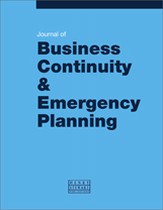Rethinking bomb threat response
Abstract
Understanding the explosive threat landscape is paramount to having a sound evacuation protocol. Security procedures and response to threats can no longer be static and uniformly applied; rather, they must be tailored to ever-evolving terrorist and criminal tactics. This paper introduces recent statistics regarding the decreasing number of domestic bombings in the USA. Data related to the increasing number of bomb threats is also brought into the discussion, along with data showing how threats are almost exclusively hoaxes. A case study of the disparate responses of two major cities to the same bomb threat reveals how and why the threat was handled differently, along with ramifications. Terrorist and criminal bombings often target evacuees and first responders, and devices, if they exist, are generally small and ineffective; therefore, sheltering in place, in the protection of the building, may be a better course of action than evacuation. The concept of treating a bomb threat as a possible dry run is discussed, along with information regarding detection of surveillance. The paper also ventures beyond data-gathering and explores the use of intuition in decision-making. These perspectives should be factored into bomb threat preparation, mitigation and response policy and procedures.
The full article is available to subscribers to the journal.
Author's Biography
Jennifer Hesterman is a retired US Air Force colonel who served three Pentagon tours and commanded in the field. Her last assignment was Vice Commander at Andrews Air Force Base, Maryland, where she led installation security, force support and the 1st Helicopter Squadron, and regularly escorted the President and other heads of state on the ramp. She is Vice President, Business Resiliency and Education Services for Watermark Risk Management International, on the board of directors for the International Foundation for Protection Officers and advises the Homeland Security Training Institute at the College of DuPage. She holds a doctoral degree from Benedictine University, master of science degrees from Johns Hopkins University and Air University, and a bachelor of science from Penn State University. She was a National Defense Fellow at the Center for Strategic and International Studies in Washington, DC and is an alumnus of the Harvard Senior Executive Fellows programme. Her book, Soft Target Hardening: Protecting People from Attack, was the ASIS Security Book of the Year for 2015. She also authored Soft Target Crisis Management (2016) and The Terrorist-Criminal Nexus (2013). Dr Hesterman is an expert on international and domestic terrorist organisations, transnational threats and organised crime. She is one of the very few analysts specialising in the terror–crime nexus. She is also a consultant on soft target vulnerabilities and hardening tactics, and has a specialist interest in issues including human intuition, concentric rings of security and ‘fifth column’ insider threats.
Citation
Hesterman, Jennifer (2019, December 1). Rethinking bomb threat response. In the Journal of Business Continuity & Emergency Planning, Volume 13, Issue 2. https://doi.org/10.69554/FSVO1626.Publications LLP
